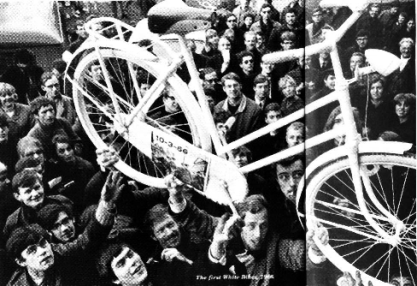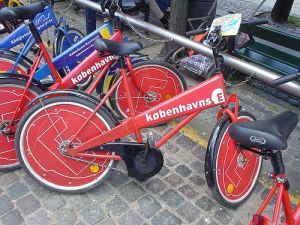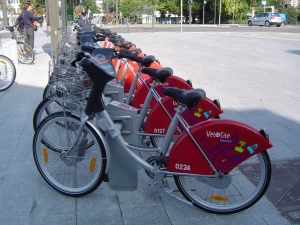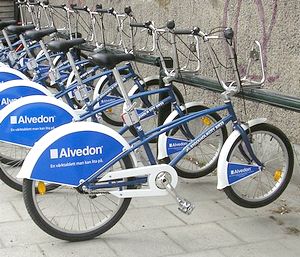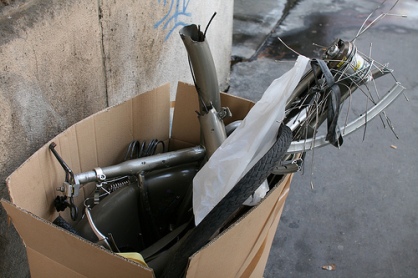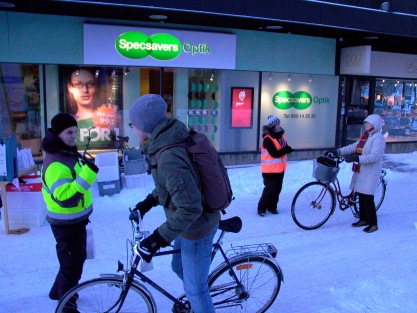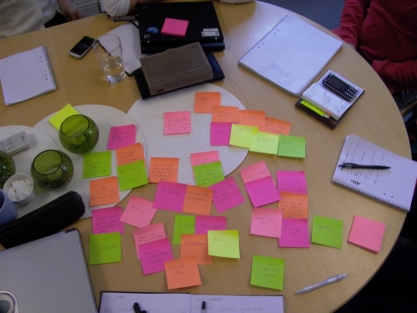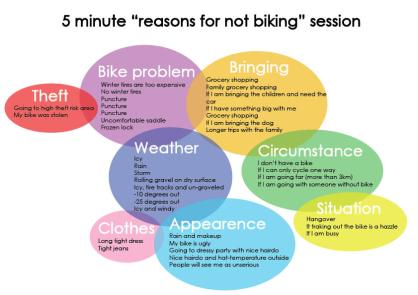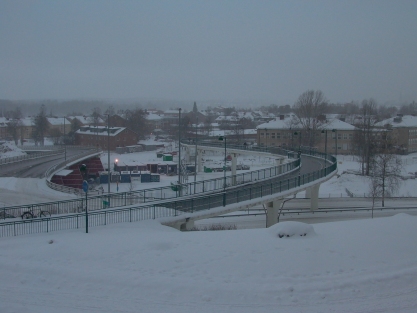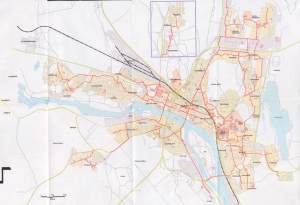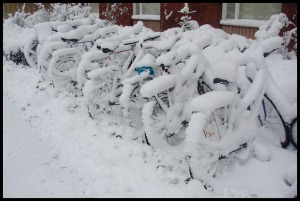Community bike history
February 12, 2009
The first well documented community bike program implementation was in Amsterdam, Netherlands in the 1960’s. The program was conceived by Luud Schimmelpennink, a member of the anarchy group, “Provo”.
Provo conceived of several “white plans” including the White Bicycle Plan. The proposal called for closing off the center of the city to motorized traffic and in it’s place distribute 20,000 white bicycles free for anyone to use. The group and their plans received international exposure due to violent actions which were taken by the police against Provo. The exposure likely was responsible for sparking the interest of others who attempted to implement similar community bike programs around the world. 1*
French port La Rochelle, France’s first – and, for many decades, only – city committed to environmentally progressive planning, pioneered such experiments with its yellow bike rental program in 1974. Despite La Rochelle’s success (its project continues to operate to this day), no other cities followed suit.
A full two decades later, Copenhagen’s free bycyklen bike-loan program, begun in 1995, served as the true European catalyst, inspiring several imitators, including Helsinki (2000) and the Danish town Arhus (2005). Aveiro in Portugal launched a free bike-loan program in 2001 and the French city of Angers opened its VéloCité system in 2004. In Switzerland, where such efforts have been initiated and operated by independent, non-profit associations rather than municipalities, bike-sharing has taken a somewhat different form. The non-profit association Genève Roule has run a free-bike program since 1997, for example, and similar initiatives exist in other cities across the Confederation. Germany’s national railway has operated the Call-a-Bike rental service since 2001, now in Berlin, Frankfurt, Munich, Cologne, Stuttgart, and Karlsruhe, and the Dutch national railway offers a similar rental service. In parallel to Deutsche Bähn’s service, a small firm called Nexbike is testing bike rental initiatives in several German cities. Across the Channel, Oybike has mounted a similar initiative in London.
But the real impetus for the recent spread of bike loan programs in Europe was more of a private sector scramble for advertising Euros. Two firms battle each other for the spoils of this lucrative European market: Clear Channel, the largest outdoor advertising corporation in the world, and its leading competitor, the French company JCDecaux (which prefers to call itself a provider of “urban furniture,” and is best known for the sleek, stylish, coin-operated, self-cleaning public toilet units it maintains on Paris’s streets). Locked in a perennial contest for municipal advertising contracts, these companies sought to sweeten their respective offers in recent years by bundling them with bike-sharing systems.
Their aggressive commercial strategies thus spawned the proliferation across the old continent of systems with cutesy names and brightly painted bicycles. Rennes launched a free bike-share system under contract with Clear Channel in 1998; and when Vienna abandoned its Copenhagen-inspired initiative after it suffered widespread vandalism in only a few weeks of operation in 2000, the city awarded JCDecaux a concession for its Citybike bike-rental program. In Norway, Clear Channel concluded contracts for rental systems with four cities in 2001 and 2002 (Trondheim, Drammen, Bergen and Oslo), JCDecaux signed with Porsgrunn in 2003, and Sandnes has run its own since 2001. Amidst this rapid profusion, Lyon’s 2005 contract with JCDecaux for its Vélo’v program was a watershed. Its fleet of 2,000 bikes made it at that time the largest in the world, and attrac
ted unprecede nted numbers of users (10 % of the city’s inhabitants are subscribed today). Lyon’s success caught city planners’ attention across Europe: the following year, JCDecaux installed the Cyclocity system in Brussels and Vél’Hello in Aix-en-Provence, Clear Channel set up Stockholm’s Citybike system, the Spanish city of Burgos put in place its own free BiciBur program, and in 2007 Orléans awarded a concession for Vélo+ to the French state railway SNCF’s subsidiary EFFIA.
The key to Vélib’s unexpected success, its unprecedented scale, also came about as something of an accident. When Paris Mayor Bertrand Delanoë decided to implement a system in Paris in the fall of 2006, he clearly had something like Lyon’s model in mind. His initial invitation for bids called for 6,000 bikes and 600 pick-up and drop-off points – had it been left at that, it would still have been the biggest in Europe, although on the same order of magnitude as Lyon’s network.
In the first round of bidding, Clear Channel beat out JCDecaux – but the French company, determined to keep a tight grip on its flagship concession on outdoor advertising in Paris, mobilized a battalion of lawyers to get the bid overturned in court. To be c
ertain that its American rival would not beat it out a second time, JCDecaux submitted a revised offer that far surpassed what the city had imagined: 20,600 bikes and a network of 1,450 stations so dense that no point within the city would be more than 300 meters away from the nearest station. Clear Channel had clearly lost and Parisians woke up to the world’s largest bike sharing network. The new system, the unlikely fruit of intense competition for advertising market share between Clear Channel and JCDecaux rather than any ecological good intentions, now made it possible for Parisians to pick up and drop off a bicycle anytime and anywhere in Paris. 2*
Sources:
1* Jared Benedict | Automatic
Community Bike Program | May 5th 2002
2* Paul Cohen | Spacing Toronto | Nov. 5th 2008
Recent development
Paris’s bicycle rental scheme that has transformed travel in the city has run into problems just 18 months after its successful launch Over half the original fleet of 15,000 specially made bicycles have disappeared, presumed stolen.
They have been used 42 million times since their introduction but vandalism and theft are taking their toll. The company which runs the scheme, JCDecaux, says it can no longer afford to operate the city-wide network.
Championed by Paris Mayor Bertrand Delanoe, the bikes were part of an attempt to “green” the capital. Parisians took to them enthusiastically. But the bikes have suffered more than anticipated, company officials have said.
Hung from lamp posts, dumped in the River Seine, torched and broken into pieces, maintaining the network is proving expensive. Some have turned up in eastern Europe and Africa, according to press reports. Since the scheme’s launch, nearly all the original bicycles have been replaced at a cost of 400 euros ($519, £351) each.
The Velib bikes have also fallen victim to a craze known as “velib extreme”. Various videos have appeared on YouTube showing riders taking the bikes down the steps in Montmartre, into metro stations and being tested on BMX courses.
Remi Pheulpin, JCDecaux’s director general, says the current contract is unsustainable. “It’s simple. All the receipts go to the city. All the expenses are ours,” he said. The costs, he said, were “so high that a private business cannot handle it alone, espcially as it’s a problem of public order. If we want the velib set-up to keep going, we’ll have to change the business model,” he told Le Parisien newspaper.
Source:
BBC News |BBC News online | Feb. 10th 2009
Breakfast on the move
February 11, 2009
5minute “resons for not cycling” session
February 5, 2009
At the meeting with Hållbart resande Project group I ceased the opportunity to do a 5minute passing around notes session, the assignment of the session was to mention as many common reasons or excuses for not cycling as possible. Mapped out the result looks like this:
Many of the statements have to do with practical matters that could present design opportunities, given that the group is sustainable travelers by occupation it is no surprize that few of the answers have to du with attitude or plain lazyness, yet personal appearence is a considerable factor.
Heated bridge
February 5, 2009
Winter cycling in Umeå
February 4, 2009
One of the challenges is to get people to cycle in the wintertime only 21% of the population between 16 and 84 years of age cycle daily in the winter season against 47% in the winter season. Lots of effort has been made already Umeå has a grid of bicycle routes that are kept clear of snow in the winter, there is even a heated cycle/pedestrian bridge on the busiest route in town.
Hållbart resande
February 4, 2009
Had an excellent meeting yesterday with Umeås sustainable travel project group (Hållbart resande) who provided a lot of information. Umeå Municipality has an incredible amount of background information and in-depth surveys on the traffic situation in and around the city.
Links
January 27, 2009
I have posted links to the best of the the websites, papers and articles I have found out there so far. More to come. Also I have yet to post some pictures to spice up this blog a little.
Presearch
January 27, 2009
Working on this blog today, posting links to all the information I have gathered so far.
Initial project description
January 20, 2009
Umebike
A City bike service connecting the cultural landscape of Umeå
Umebike
Is a project that aims at opening up the cultural landscape of Umeå to visitors, as well as providing a convenient, enjoyable and sustainable means of transp0rtation to the citizens of Umeå that promotes the joys of bicycling
Travel
Umeå is ideal for bicycling, few steep hills, small geographical extension 180km of bicycle paths and an additional 160km of trekking paths make perfect conditions for bicycling all over Umeå.
For the 29.000 students of Umeå University as well as for many who live and work in the city, the daily transportation of choice is by bicycle even in the winter season. For this reason the number of bicycles in Umeå is high, but unfortunately also bicycle thefts. The common sight of abandoned bicycles in Umeå bears witness to this fact. A city bike service could help promoting bicycling as well as preventing bicycle theft.
Experience
Apart from being a great means of daily transportation bicycling is an excellent way to experience Umeå, the distances to cover are within bicycle range, and the most beautiful routes are accessible only on foot or on bicycle. On a bike it is easy to go from the museums at Gammlia though the beautiful town center and along the river on the scenic bicycle route Umeleden that connects historical sites with modern art exhibitions.
Explore
Being the cultural capital of northern Sweden Umeå has thousands of visitors each year, both regular visitors who come to Umeå often for culture and shopping. And conference guests or tourists who spend some days in Umeå with time to explore the shops and sights of Umeå and maybe more importantly experience the atmosphere of this northern hub with its weave of old and new, city and nature.
Umebike
Is an exploratory project looking into the possibilities of enhancing the bicycle culture of Umeå and connecting the city tighter together by providing a system of public bikes for the residents and visitors in Umeå. A vision for what a public bike system for Umeå would look like and how it would work.
Aside from the design of the bicycle itself there are many questions to be answered.
-How would this system promote Umeå culture and sustainable transportation?
-Who are the users and how are they reached?
-How should a payment/return system work?
-How should it be connected to the public transportation?
-Could the system include updateable/interactive information about Umeå?
-What would the practical implications of public bikes in Umeå be?
Objective
The goal of the project is to design a public bicycle system tailored to Umeå with the purpose of promoting culture and sustainable transportation. This reliable and accessible extension of the public transportation system in Umeå has the purpose of enhancing the convenience of bicycling in Umeå, both for citizens and visitors who will have a new, healthy, sustainable and beautiful way of getting around the city.
A well designed solution for a publicly available and very visible system like this will enhance the design profile of Umeå that is home to one of the top design educations in the world.
The project should be realizable before 2014 to support the ambition of being European cultural capital.
